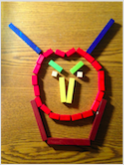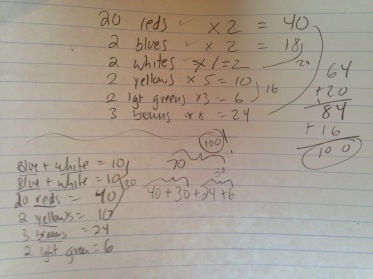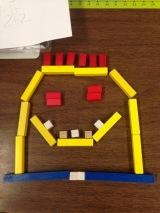Full disclosure: I am a district math coach. I work with K-12 teachers in 6 different buildings. I am always seeing something shiny. I am never bored. This blog is the space where I take all those shiny things and try to create something coherent and, perhaps, beautiful. It is my chance to make sense of all the bits and pieces. It takes me a while to pull it all together. Brevity is not my strength. This post still feels clunky. Consider yourself warned.
On Wednesday, I went back into Mrs. R’s third grade class. She and I have been collaborating to help her students build stamina for persevering. I originally wrote about this here.
After last week’s lesson, I thought a lot about where we should go next with these students. I kept trying to make it about the math. Should I do a mini-lesson about equivalence? Should I juxtapose student’s strategies to encourage more efficient strategies?
Something didn’t feel right. It still felt forced. My original goal was to encourage perseverance – to build stamina. I have learned from experience that stamina is directly related to engagement. There were still quite a few students who built a #hundredface that was not equivalent to 100. I wondered, do they care that their face might not equal 100? Are they engaged enough to want to make adjustments to it? THIS is what interested me.
As I continued to let my third grade plans simmer, I began to plan the Elementary Learning Rounds that I was going to facilitate. This year, our learning rounds are focussing on the NCTM teaching practice, Supporting Productive Struggle in Learning Math. As I planned the debriefing meeting for the learning rounds, I wondered: When is struggle productive? What does it look like? How does it become unproductive? What do we do when struggle becomes unproductive? How does struggle relate to engagement?
How does struggle impact our work with the hundred face challenge? At this point in my planning, I felt stuck. So, I decided to work on a hundred face. I wanted to build an owl. Owls are my favorite animal. I connect with owls. I took out a bunch of Cuisinaire rods and started to build. I looked at pictures of owls. My first owl was equivalent to 122 Cuisinaire units. Too big. But I loved it! I didn’t want to change it. Enter struggle. Should I start over? Should I build something else? No. I am going to start tweaking it. What do I know about Cuisinaire rods? Well I am going to need less rods AND less units. I can’t just replace the smaller rods with larger rods because that might not change the total value or, worse, it might increase the total value. Hmm. I have 4 rods that are equivalent to 7 so that is a total of 28. If I take those rods away I will be down 28 (-28). If I replace them with 3 rods that are equivalent to 6 then I would have +18. So -28 +18 = -10. I would be down 10 units so I am still over because 122-10 = 112. I kept going with this line of thinking. It was a struggle, but it felt productive because my owl was changing in a beautiful way AND I was making connections to integers. Could I do this activity with some of the middle school classes? The math was leveraging my creativity. The creativity was leveraging the math. Here is where I landed:


Now what? I am psyched because I made a cool owl. What does this have to do with the third graders with whom I am supossed to work in one hour? Should I share my work with them? How? I guess I could rebuild my owl and put it under the doc camera. I wish I didn’t have to put the cubes away. Maybe I don’t. I could cut out paper Cuisinaire rods and build a replica of my owl. That would be cool, but I wouldn’t have the shadows or the cool wood grain background. Let’s just see what it looks like:

This is kind of cool. I wonder if the third graders would be interested in making their hundred faces more permanent? It will take me a long time to cut out all those pieces. I am not just handing those out wily nily. If they want to make a paper copy of their hundred face, they will need to prove it is equivalent to 100. Hmm. Am I making the math more relevant?
Enter the voice of Dan Meyer. On Twitter this week, I was following a series of conversations about whether it was possible to create a math lesson about Bottle Flipping that was truly relevant. Does the relevance leverage the math? I read Dan’s blog post and all the comments. I watched his NCTM talk again. I thought about this:
- “We need to focus on the rot not the coat of paint.”
- “Teachers are so eager to get to the answer that we do not devote sufficient time to developing the question.”
- “How mathy does the room feel right now?”
I decided I was going to share my idea with the third graders and see what they thought. I started the lesson by sharing the story of my owl. They were intrigued. They were actually pretty excited to make their own paper hundred faces. I told them about the constraint: You have to prove, without a doubt, that your face is equivalent to 100. I am not wasting little paper pieces. Then, I took them on a field trip to the entrance hallway in our school. I told them I thought we should hang our faces on clothesline across the ceiling tiles so that everyone will see them when we come into the school. They loved this idea. They commented that we better make sure our math is correct if we are going to be displaying it.
When we got back to the classroom, every student got to work:
Please note that these faces are NOT all equivalent to 100 because the work is NOT done. These students need more time to struggle. Many of them have moved on to the justification portion of the task. Several have already figured out that they will need to make adjustments. One boy spent almost twenty minutes working out the math for his face:
Originally, he did not have 4 brown rods in the center and he only had one brown rod for each wing, but he added the rods in the center because the didn’t have “enough” to equal 100. He had some calculation errors when he determined what 8+8+8+8+8+8 was. I believe he was off by 8. However, he was correct about needing more units to reach 100. After he added more brown rods, he realized that he had too many. This child spent the entire class revising his thinking. He still has more revising to do. However, in the last 5 minutes of the class, amidst groans of frustration, he said, “I don’t even have to do the addition. I already know it is too many.” Mrs. R said, “Tell me how you know that.” He said, because 70 plus 60 is more than 100 so 76 + 64 will definitely be more than 100. His teacher said, “Wow. If you already know that then you know a lot. Next week, we can start with what you have and see if we can keep adjusting it.” He asked me to take a picture of his eagle so he could remember where he left off.
These students are in a beautiful place. They are learning that their discomfort is leveraging their creativity and their mathematical understanding. This takes time. I think, next week, we can dial-up the math a little by focussing on precision. My next question is how do I ensure that I am dialing it up thoughtfully and intentionally?














